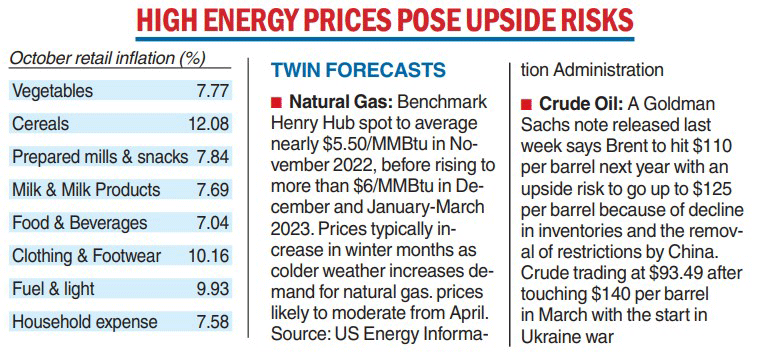The inflation gauges have started to cool.
Retail inflation tumbled to 6.77 per cent in October — a sharp plunge from 7.41 per cent in the previous month — while wholesale price inflation, which is based on a broader basket of goods and different weights – also sank to a 19-month low at 8.39 per cent from 10.70 per cent in the previous month.
The Reserve Bank of India, independent economists and market pundits had been anticipating a fall in retail inflation in the third quarter (October-December) and the price barometer indicated that they were right.
But it may be too early to pop the champagne: energy prices — especially crude oil and natural gas — threaten to rally again as a cold winter of discontent settles over Europe and global supply chains start to clank in distress as a pall of economic gloom descends over advanced economies and China.
Retail inflation fell in October because of a slower rise in food prices, but continued to be above the Reserve Bank of India’s tolerance level of 6 per cent, which could result in a lower rate hike in the next policy review in December.
Data released by the National Statistical Office on Monday showed food inflation falling to 7.01 per cent from 8.6 per cent in September, while fuel inflation remained elevated at 9.93 per cent.

The consumer price index (CPI) based retail inflation has remained above the 6 per cent target since January this year. The RBI had to send a report to the Centre explaining why it wasn’t able to cap inflation below 6 per cent for three consecutive quarters.
Another set of data released earlier in the day showed wholesale price-index based inflation falling to 8.39 per cent on easing prices of food, fuel and manufactured items.
“While the decline in retail inflation is good news for the economy, continuous increase in cereals inflation does not augur well for the households at the bottom of the income pyramid, as they spend a disproportionately larger share of their income/ expenditure on food products. Cereals and product inflation has been in excess of 5 per cent since March 2022 and in double digits in the past two months,” Sunil Sinha, principal economist, India Ratings & Research, said.
Rajani Sinha, chief economist, CareEdge said: “We expect the RBI to be less hawkish in its upcoming December policy meet and go for a 35-bps rate hike. Nonetheless, there is a need to closely monitor the impact of volatility in food inflation and the impact of exchange rate on imported inflation.”
“Factoring in the upside risk from food inflation, we have revised our inflation forecast for FY23 upwards to 6.8 per cent (earlier 6.5 per cent). We expect inflation to average 6.6 per cent in the third quarter and 6.2 per cent in the fourth quarter of this fiscal. CPI inflation could fall below 6 per cent only by the end of this fiscal.”
“The near-term inflation outlook is clouded by a few risks such as the recent sequential rise in the prices of global commodities, supply disruptions for perishables owing to excess rains and robust demand for services. Nevertheless, a high base is expected to further soften the annual CPI inflation to around 6 per cent in November 2022,” Aditi Nayar, chief economist, ICRA said.
She said with CPI inflation remaining solidly above the MPC’s 6 per cent tolerance level in October, another rate hike is certain in December. However, its size is likely to be tempered to 35 bps from the 50 bps seen in the last three reviews, given the moderation in inflation and the expectations of a further dip in November.










